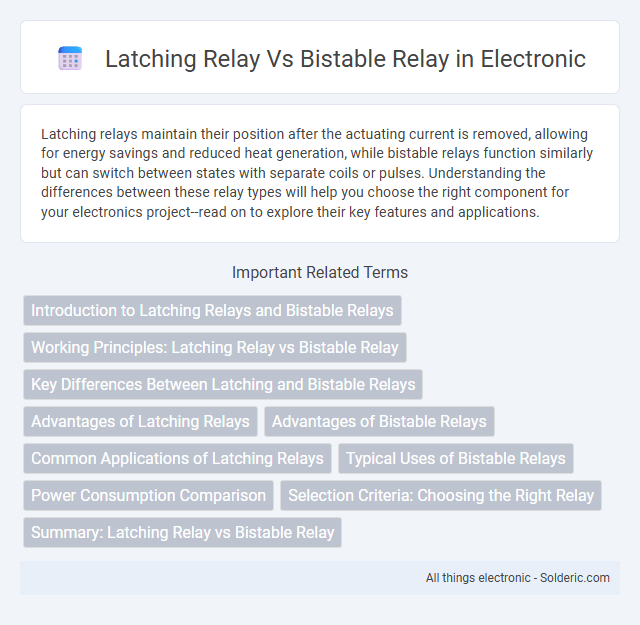Latching relays maintain their position after the actuating current is removed, allowing for energy savings and reduced heat generation, while bistable relays function similarly but can switch between states with separate coils or pulses. Understanding the differences between these relay types will help you choose the right component for your electronics project--read on to explore their key features and applications.
Comparison Table
| Feature | Latching Relay | Bistable Relay |
|---|---|---|
| Definition | Relay that maintains its contact position after the coil is energized and de-energized. | Relay with two stable states, switched by applying a control signal. |
| Operation | Uses magnetic latch to hold position without continuous power. | Switches between states with alternating coil energization. |
| Power Consumption | Low power; only momentary power needed to change state. | Low power; power required only during switching. |
| Applications | Memory circuits, power saving controls, remote switching. | Switching circuits, automation, devices requiring stable states. |
| Contact Configuration | Typically SPDT or DPDT contacts. | Varies; often SPDT or DPDT. |
| Advantages | Maintains position without power; reduces energy consumption. | Reliable switching with clear on/off states. |
| Disadvantages | More complex coil driving circuitry. | Requires continuous coil control for switching states. |
Introduction to Latching Relays and Bistable Relays
Latching relays and bistable relays both maintain their position without continuous power by using magnetic or mechanical mechanisms to hold contacts stable. Latching relays utilize a coil pulse to switch states and remain latched until another pulse changes the state, making them energy efficient for memory functions in circuits. Bistable relays operate similarly by toggling between two stable states but often involve different design aspects tailored for specific applications requiring reliable switching with minimal power consumption.
Working Principles: Latching Relay vs Bistable Relay
Latching relays operate by maintaining their position after being actuated, using a magnetic latch or mechanical catch to stay in either the energized or de-energized state without continuous power. Bistable relays function similarly, with two stable states held by permanent magnets, allowing them to retain their position without constant electrical input. When choosing between a latching relay and a bistable relay, understanding their working principles helps ensure your application benefits from energy efficiency and reliable state retention.
Key Differences Between Latching and Bistable Relays
Latching relays maintain their position after the actuating coil is energized and de-energized, using a magnetic or mechanical latch to hold the contacts, which conserves energy by requiring power only during switching. Bistable relays, often used interchangeably with latching relays, typically have two stable states and can be toggled back and forth with separate coil inputs, making them ideal for applications requiring reliable state retention without continuous power. Understanding these key differences helps you select the appropriate relay type for energy-efficient and stable switching in your electrical circuits.
Advantages of Latching Relays
Latching relays offer significant energy efficiency by maintaining their position without continuous power, unlike bistable relays that may require sustained input signals. Their non-volatile state retention ensures reliable operation during power interruptions, making them ideal for memory-sensitive applications. Additionally, latching relays generate less heat and extend component lifespan due to reduced coil current requirements.
Advantages of Bistable Relays
Bistable relays offer significant energy efficiency by maintaining their state without continuous power, reducing operational costs and heat generation in your system. Their dual stable positions provide reliable memory for switching applications where power interruptions occur, ensuring consistent performance. These relays also enable faster switching speeds and enhanced durability compared to latching relays, making them ideal for long-term, energy-conscious automation projects.
Common Applications of Latching Relays
Latching relays are commonly used in applications requiring energy-efficient switching, such as lighting control systems, security alarm circuits, and remote switching operations in industrial automation. Their ability to maintain position without continuous power makes them ideal for battery-powered devices and smart home automation. When selecting relays for your project, understanding these practical use cases ensures optimal performance and energy savings.
Typical Uses of Bistable Relays
Bistable relays are commonly used in energy-efficient lighting systems, smart home automation, and industrial control circuits due to their ability to maintain position without continuous power supply. Typical applications include controlling LED lighting, motor starters, and memory retention in automation devices. Their low power consumption and reliable state retention make them ideal for remote switching and battery-operated equipment.
Power Consumption Comparison
Latching relays consume power only during the switching operation, making them highly energy-efficient compared to bistable relays, which require continuous power to maintain their state. This characteristic significantly reduces overall power consumption in applications where the relay position remains stable for extended periods. Choosing a latching relay can help Your system minimize energy usage and increase operational efficiency.
Selection Criteria: Choosing the Right Relay
Selecting the right relay involves evaluating power consumption, switching speed, and application stability. Latching relays excel in low-power applications due to their ability to maintain position without continuous power, while bistable relays provide quick switching and are ideal for frequent state changes. Your choice should prioritize energy efficiency and operational frequency to ensure optimal performance in the intended circuit.
Summary: Latching Relay vs Bistable Relay
Latching relays and bistable relays both maintain their position without continuous power, enhancing energy efficiency in control systems. Latching relays use a pulse to toggle between states and often require a mechanical or magnetic reset, whereas bistable relays hold their position through magnetic forces without additional power. Understanding the differences helps you select the appropriate relay type for stable, low-power switching applications.
Latching Relay vs Bistable Relay Infographic

 solderic.com
solderic.com